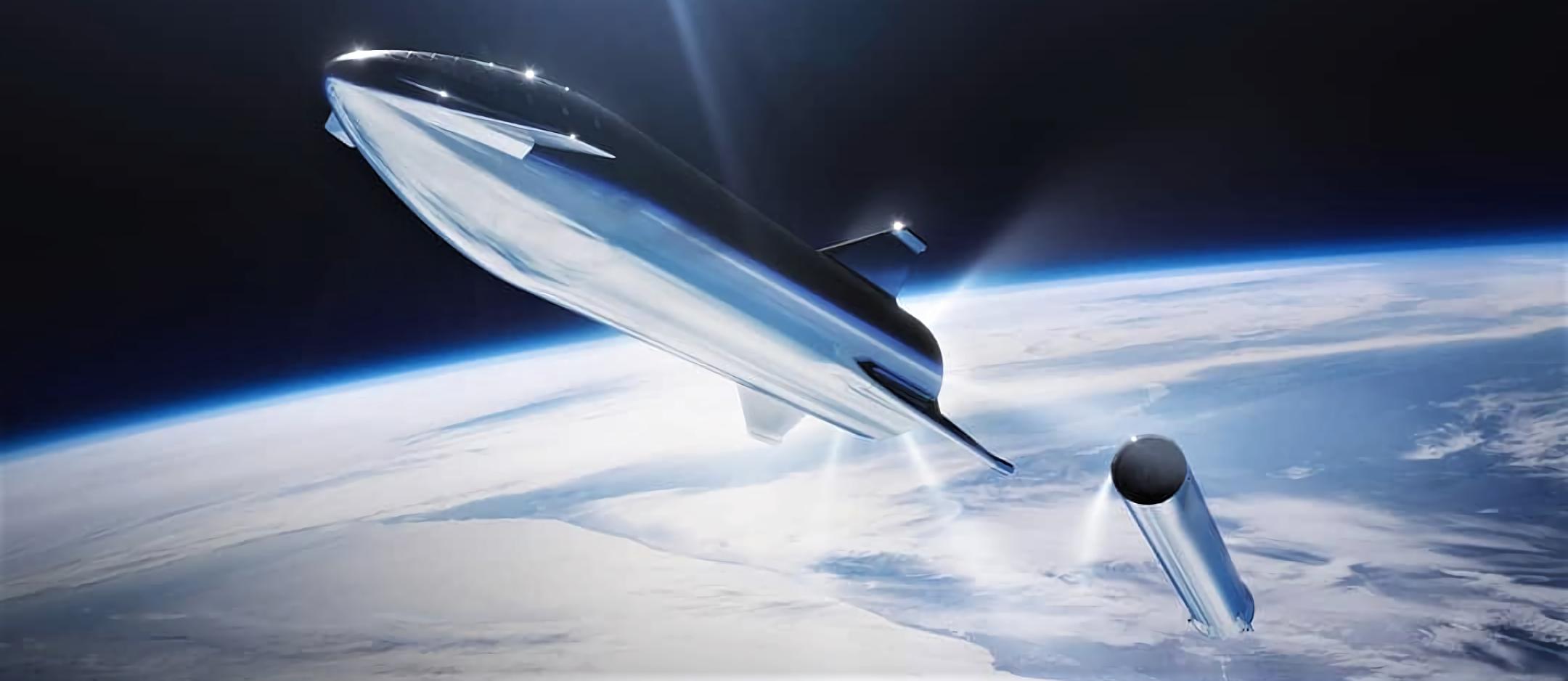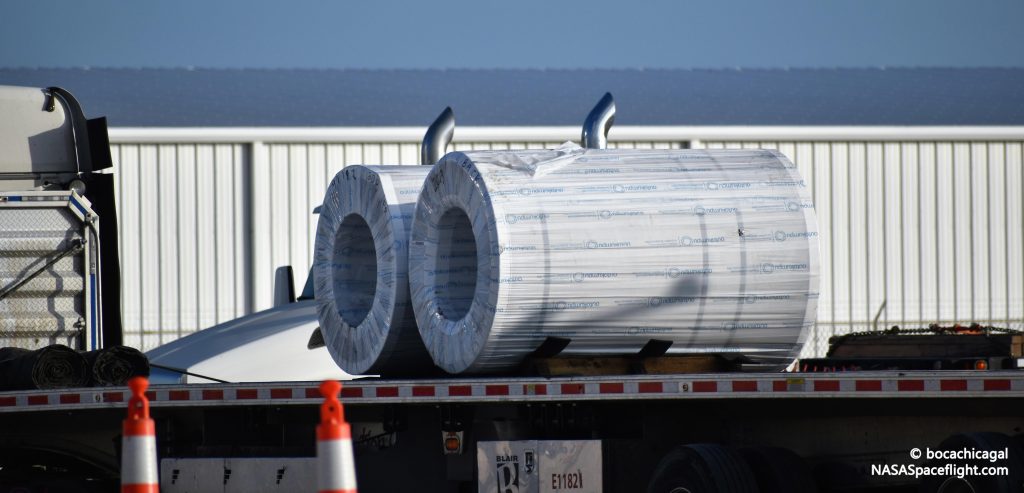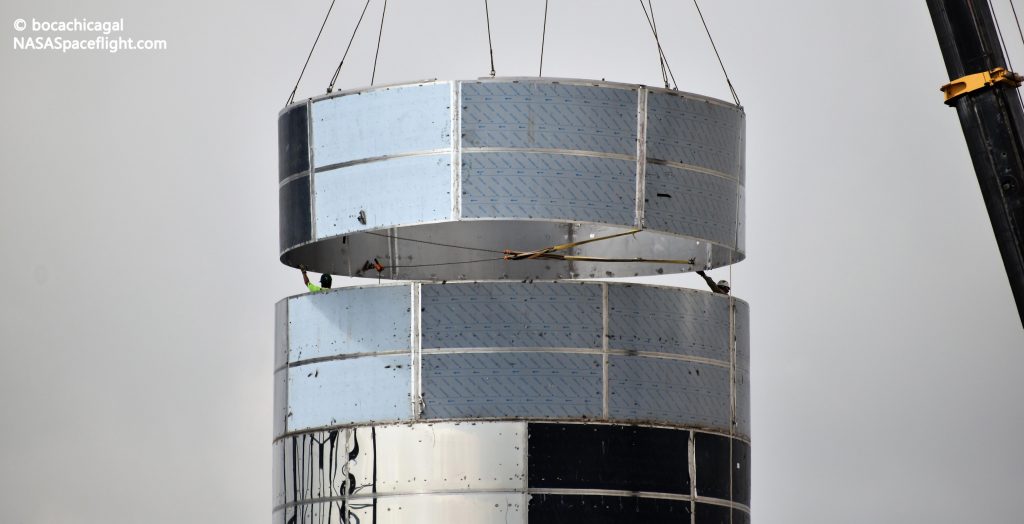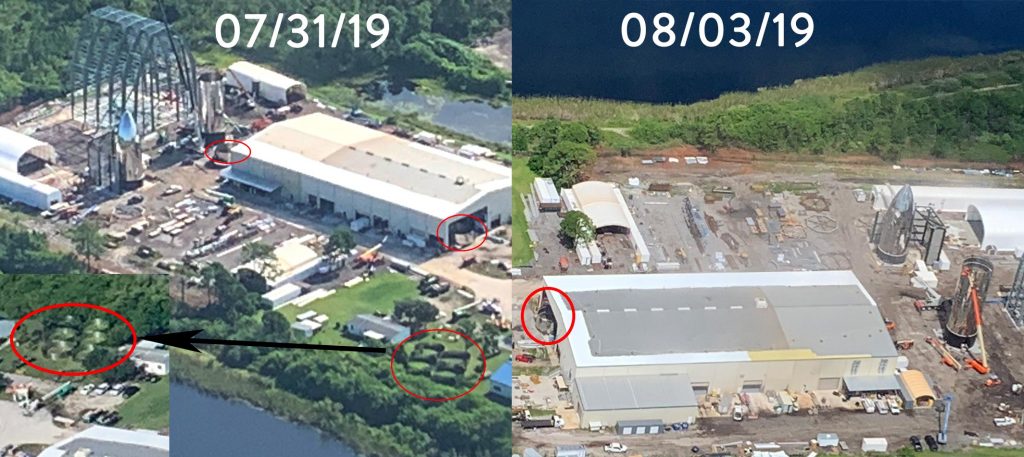

News
SpaceX’s first Super Heavy hardware is already being built at Florida Starship campus
Based on some basic analysis of recent photos of SpaceX’s East Coast Starship facility, situated in Cocoa, Florida, SpaceX has almost certainly begun fabricating and staging hardware that will eventually become part of the company’s first Super Heavy booster prototype.
This is by no means surprising but it does confirm the reasonable assumption that SpaceX is already working hard to ensure that the first Super Heavy booster(s) can be assembled as quickly as possible. Additionally, SpaceX appears to have started clearing brush in the process of preparing to transport the Florida orbital Starship prototype (“Mk2”) to SpaceX’s Pad 39A launch facilities, dozens of miles away.
Counting rings
The aforementioned “basic analysis” is more or less comprised of looking for and counting the massive steel rings that SpaceX has decided to build its Starships (and Super Heavy boosters) out of. By all appearances, SpaceX is doing nearly everything short of milling and preparing the raw materials (steel) internally. In Florida and Texas, giant rolls of stainless steel are delivered to the worksite by semi-truck, where SpaceX technicians prepare the rolls for sectioning (likely with a plasma torch or laser) and any necessary machining.


Intriguingly, SpaceX’s Texas and Florida teams are using different sizes of sheets – Florida has gone for taller segments while Texas uses rings that are a fair bit shorter ring, welding two rings together before installing each section on Starship. Florida’s rings are roughly 1.8m (6 ft; +/- 5%) tall.
In August alone, Cocoa has effectively doubled the height of the barrel section of its Mk2 orbital Starship prototype, jumping from 7-8 to 15 steel rings. The barrel section is now ~28m (90 ft) tall and Starship Mk2’s pointed nose section is still approximately 20-22m (65-70 ft) tall, adding up to a stacked height of 48-50m, approximately 10% shy of its final 55m (180 ft) height. Assuming that SpaceX hasn’t stretched Starship further since CEO Elon Musk’s September 2018 update, this leaves Starship Mk2 around 2-4 rings and a small nose cap shy of its full height (excluding legs).
Super Heavy rising
This brings us to even more recent views of SpaceX’s Cocoa Starship facility, taken on August 15th by local pilot Brian (Twitter: @flying_briann). A video from the flight offers an uninterrupted ~360-degree overview of the site, including glimpses of a surprising number of staged steel rings that have completed initial welding and are waiting for stacking and integration.
Two photos taken a bit less than two weeks ago provide a decent overview of SpaceX’s Cocoa facility. Of note, six staged rings are visible, as well as four additional rings in the form of two stacked sections of two rings. Those latter two sections (four rings) have since been stacked on Starship’s tank section, bringing it to its current 15-ring, ~28m height.

Despite the fact that Starship Mk2 appears to be just a few rings away from its final height, Brian’s August 15th overview revealed that no fewer than 11 additional rings (18m, 60 ft) are either staged or in the final stages of welding. Even if SpaceX has significantly stretched Starship over the last 10 or so months of design iteration, it seems exceedingly unlikely that Starship has grown by a full 10-12m (~20%).
Rather, these rings are probably the beginnings of SpaceX’s first Super Heavy booster prototype, a necessity before Starship can begin crucial orbital flight tests. Per the vehicle’s official 2018 specifications, Super Heavy will stand at least 63m (205 ft) tall before accounting for its landing legs/fins, requiring around 35 steel rings to complete its propellant tanks, interstage, and thrust structure.

According to CEO Elon Musk, Super Heavy will likely perform its first flight tests with approximately 20 Raptor engines, eventually arriving at a full 31-37 engines depending on the configuration. Musk also believes that Starship could be ready for its first orbital flight tests as early as December 2019, implying that SpaceX’s first Super Heavy prototype(s) could be fully assembled as few as 4-5 months from now.
In reality, 2020 is far more likely for both milestones, but Musk is not exactly well-known for his conservative schedule estimates.
Check out Teslarati’s Marketplace! We offer Tesla accessories, including for the Tesla Cybertruck and Tesla Model 3.
Elon Musk
Tesla reveals it is using AI to make factories more sustainable: here’s how
Tesla is using AI in its Gigafactory Nevada factory to improve HVAC efficiency.

Tesla has revealed in its Extended Impact Report for 2024 that it is using Artificial Intelligence (AI) to enable its factories to be more sustainable. One example it used was its achievement of managing “the majority of the HVAC infrastructure at Gigafactory Nevada is now AI-controlled” last year.
In a commitment to becoming more efficient and making its production as eco-friendly as possible, Tesla has been working for years to find solutions to reduce energy consumption in its factories.
For example, in 2023, Tesla implemented optimization controls in the plastics and paint shops located at Gigafactory Texas, which increased the efficiency of natural gas consumption. Tesla plans to phase out natural gas use across its factories eventually, but for now, it prioritizes work to reduce emissions from that energy source specifically.
It also uses Hygrometric Control Logic for Air Handling Units at Giafactory Berlin, resulting in 17,000 MWh in energy savings each year. At Gigafactory Nevada, Tesla saves 9.5 GWh of energy through the use of N-Methylpyrrolidone refineries when extracting critical raw material.
Perhaps the most interesting way Tesla is conserving energy is through the use of AI at Gigafactory Nevada, as it describes its use of AI to reduce energy demand:
“In 2023, AI Control for HVAC was expanded from Nevada and Texas to now include our Berlin-Brandenburg and Fremont factories. AI Control policy enables HVAC systems within each factory to work together to process sensor data, model factory dynamics, and apply control actions that safely minimize the energy required to support production. In 2024, this system achieved two milestones: the majority of HVAC infrastructure at Gigafactory Nevada is now AI-controlled, reducing fan and thermal energy demand; and the AI algorithm was extended to manage entire chiller plants, creating a closed-loop control system that optimizes both chilled water consumption and the energy required for its generation, all while maintaining factory conditions.”
Tesla utilizes AI Control “primarily on systems that heat or cool critical factory production spaces and equipment.” AI Control communicates with the preexisting standard control logic of each system, and any issues can be resolved by quickly reverting back to standard control. There were none in 2024.
Tesla says that it is utilizing AI to drive impact at its factories, and it has proven to be a valuable tool in reducing energy consumption at one of its facilities.
Elon Musk
Tesla analysts believe Musk and Trump feud will pass
Tesla CEO Elon Musk and U.S. President Donald Trump’s feud shall pass, several bulls say.

Tesla analysts are breaking down the current feud between CEO Elon Musk and U.S. President Donald Trump, as the two continue to disagree on the “Big Beautiful Bill” and its impact on the country’s national debt.
Musk, who headed the Department of Government Efficiency (DOGE) under the Trump Administration, left his post in May. Soon thereafter, he and President Trump entered a very public and verbal disagreement, where things turned sour. They reconciled to an extent, and things seemed to be in the past.
However, the second disagreement between the two started on Monday, as Musk continued to push back on the “Big Beautiful Bill” that the Trump administration is attempting to sign into law. It would, by Musk’s estimation, increase spending and reverse the work DOGE did to trim the deficit.
Every member of Congress who campaigned on reducing government spending and then immediately voted for the biggest debt increase in history should hang their head in shame!
And they will lose their primary next year if it is the last thing I do on this Earth.
— Elon Musk (@elonmusk) June 30, 2025
President Trump has hinted that DOGE could be “the monster” that “eats Elon,” threatening to end the subsidies that SpaceX and Tesla receive. Musk has not been opposed to ending government subsidies for companies, including his own, as long as they are all abolished.
How Tesla could benefit from the ‘Big Beautiful Bill’ that axes EV subsidies
Despite this contentious back-and-forth between the two, analysts are sharing their opinions now, and a few of the more bullish Tesla observers are convinced that this feud will pass, Trump and Musk will resolve their differences as they have before, and things will return to normal.
ARK Invest’s Cathie Wood said this morning that the feud between Musk and Trump is another example of “this too shall pass:”
BREAKING: CATHIE WOOD SAYS — ELON AND TRUMP FEUD “WILL PASS” 👀 $TSLA
She remains bullish ! pic.twitter.com/w5rW2gfCkx
— TheSonOfWalkley (@TheSonOfWalkley) July 1, 2025
Additionally, Wedbush’s Dan Ives, in a note to investors this morning, said that the situation “will settle:”
“We believe this situation will settle and at the end of the day Musk needs Trump and Trump needs Musk given the AI Arms Race going on between the US and China. The jabs between Musk and Trump will continue as the Budget rolls through Congress but Tesla investors want Musk to focus on driving Tesla and stop this political angle…which has turned into a life of its own in a roller coaster ride since the November elections.”
Tesla shares are down about 5 percent at 3:10 p.m. on the East Coast.
Elon Musk
Tesla scrambles after Musk sidekick exit, CEO takes over sales
Tesla CEO Elon Musk is reportedly overseeing sales in North America and Europe, Bloomberg reports.

Tesla scrambled its executives around following the exit of CEO Elon Musk’s sidekick last week, Omead Afshar. Afshar was relieved of his duties as Head of Sales for both North America and Europe.
Bloomberg is reporting that Musk is now overseeing both regions for sales, according to sources familiar with the matter. Afshar left the company last week, likely due to slow sales in both markets, ending a seven-year term with the electric automaker.
Tesla’s Omead Afshar, known as Elon Musk’s right-hand man, leaves company: reports
Afshar was promoted to the role late last year as Musk was becoming more involved in the road to the White House with President Donald Trump.
Afshar, whose LinkedIn account stated he was working within the “Office of the CEO,” was known as Musk’s right-hand man for years.
Additionally, Tom Zhu, currently the Senior Vice President of Automotive at Tesla, will oversee sales in Asia, according to the report.
It is a scramble by Tesla to get the company’s proven executives over the pain points the automaker has found halfway through the year. Sales are looking to be close to the 1.8 million vehicles the company delivered in both of the past two years.
Tesla is pivoting to pay more attention to the struggling automotive sales that it has felt over the past six months. Although it is still performing well and is the best-selling EV maker by a long way, it is struggling to find growth despite redesigning its vehicles and launching new tech and improvements within them.
The company is also looking to focus more on its deployment of autonomous tech, especially as it recently launched its Robotaxi platform in Austin just over a week ago.
However, while this is the long-term catalyst for Tesla, sales still need some work, and it appears the company’s strategy is to put its biggest guns on its biggest problems.
-

 Elon Musk1 day ago
Elon Musk1 day agoTesla investors will be shocked by Jim Cramer’s latest assessment
-

 News6 days ago
News6 days agoTesla Robotaxi’s biggest challenge seems to be this one thing
-

 News2 weeks ago
News2 weeks agoTesla’s Grok integration will be more realistic with this cool feature
-

 Elon Musk2 weeks ago
Elon Musk2 weeks agoElon Musk slams Bloomberg’s shocking xAI cash burn claims
-

 News2 weeks ago
News2 weeks agoTesla China roars back with highest vehicle registrations this Q2 so far
-

 News2 weeks ago
News2 weeks agoTexas lawmakers urge Tesla to delay Austin robotaxi launch to September
-

 News2 weeks ago
News2 weeks agoTesla dominates Cars.com’s Made in America Index with clean sweep
-

 Elon Musk1 week ago
Elon Musk1 week agoFirst Look at Tesla’s Robotaxi App: features, design, and more




















